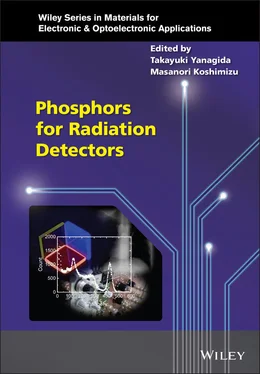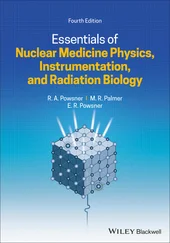Phosphors for Radiation Detectors
Здесь есть возможность читать онлайн «Phosphors for Radiation Detectors» — ознакомительный отрывок электронной книги совершенно бесплатно, а после прочтения отрывка купить полную версию. В некоторых случаях можно слушать аудио, скачать через торрент в формате fb2 и присутствует краткое содержание. Жанр: unrecognised, на английском языке. Описание произведения, (предисловие) а так же отзывы посетителей доступны на портале библиотеки ЛибКат.
- Название:Phosphors for Radiation Detectors
- Автор:
- Жанр:
- Год:неизвестен
- ISBN:нет данных
- Рейтинг книги:3 / 5. Голосов: 1
-
Избранное:Добавить в избранное
- Отзывы:
-
Ваша оценка:
- 60
- 1
- 2
- 3
- 4
- 5
Phosphors for Radiation Detectors: краткое содержание, описание и аннотация
Предлагаем к чтению аннотацию, описание, краткое содержание или предисловие (зависит от того, что написал сам автор книги «Phosphors for Radiation Detectors»). Если вы не нашли необходимую информацию о книге — напишите в комментариях, мы постараемся отыскать её.
Phosphors for Radiation Detectors
Discover a comprehensive overview of luminescence phosphors for radiation detection Phosphors for Radiation Detection,
Phosphors for Radiation Detection
Phosphors for Radiation Detection
Phosphors for Radiation Detectors — читать онлайн ознакомительный отрывок
Ниже представлен текст книги, разбитый по страницам. Система сохранения места последней прочитанной страницы, позволяет с удобством читать онлайн бесплатно книгу «Phosphors for Radiation Detectors», без необходимости каждый раз заново искать на чём Вы остановились. Поставьте закладку, и сможете в любой момент перейти на страницу, на которой закончили чтение.
Интервал:
Закладка:
58 58. Mikhailik, V.B. and Kraus, H. (2010). Performance of scintillation materials at cryogenic temperatures. Phys. Status Solidi B 247: 1583–1599.
59 59. Dorenbos, P. (2002). Light output and energy resolution of Ce3+‐doped scintillators. Nucl. Instrum. Methods Phys. Res. A 486: 208–213.
60 60. Alekhin, M.S., de Haas, J.T.M., Khodyuk, I.V. et al. (2013). Improvement of γ‐ray energy resolution of LaBr3:Ce3+ scintillation detectors by Sr2+ and Ca2+ co‐doping. Appl. Phys. Lett. 102: 161915.
61 61. Stand, L., Zhuravleva, M., Lindsey, A. et al. (2013) Potassium Strontium Iodide: A New High Light Yield Scintillator with 2.4% Energy Resolution, 2013 IEEE Nuclear Science Symposium and Medical Imaging Conference (2013 NSS/MIC), conference record
62 62. Moszyński, M., Zalipska, J., Balcerzyk, M. et al. (2002). Intrinsic energy resolution of NaI(Tl). Nucl. Instrum. Methods Phys. Res. A. 484: 459–469.
63 63. van Loef, E.V.D., Dorenbos, P., Kramer, K. et al. (2001). Scintillation properties of LaCl3: Ce3+ crystals: fast, efficient, and high‐energy resolution scintillators. IEEE Trans. Nucl. Sci. 48: 341–345.
64 64. Kelley, G.G., Bell, P.R., Davis, R.C. et al. (1956). Intrinsic scintillator resolution. IRE Trans. Nucl. Sci. 3: 57–58.
65 65. Syntfeld‐Kazuch, A., Swiderski, L., Czarnacki, W. et al. (2006). Non‐proportionality and Energy Resolution of CsI(Tl). IEEE Nuclear Science Symposium Conference Record 2006: N30–N134.
66 66. Chewpraditkula, W. and Moszynski, M. (2011). Scintillation properties of Lu3Al5O12, Lu2SiO5 and LaBr3 crystals activated with cerium. Phys. Proc. 22: 218–226.
67 67. Uchiyama, Y., Kouda, M., Tanihata, C. et al. (2001). Study of energy response of Gd2SiO5:Ce3+ scintillator for the ASTRO‐E hard X‐ray detector. IEEE Trans. Nucl. Sci. 48: 379–384.
68 68. Dorenbos, P. (2010). Fundamental limitations in the performance of Ce3+‐, Pr3+‐, and Eu2+‐activated scintillators. IEEE Trans. Nucl. Sci. 57: 1162–1167.
69 69. Gundacker, S., Turtos, R.M., Kratochwil, N. et al. (2020). Experimental time resolution limits of modern SiPMs and TOF‐PET detectors exploring different scintillators and Cherenkov emission. Phys. Med. Biol. 65: 1–20.
70 70. Matsuzawa, T., Aoki, Y., Takeuchi, T. et al. (1996). A new long phosphorescent phosphor with high brightness, SrAl2O4:Eu2+,Dy3+. J. Electrochem. Soc. 143: 2670–2673.
71 71. Nesshi‐Tedaldi, F., Dissertori, G., Lecomte, P. et al. (2009). Studies of Cerium floride, LYSO and lead tungstate crystals expose to high hadron fluences, IEEE NSS MIC 2009 Conference record N32‐3
72 72. Grescovich, G., Cusano, D., Hoffman, D. et al. (1992). Ceramic scintillators for advanced, medical X‐ray‐detectors. Am. Ceram. Soc. Bull. 71: 1120–1130.
73 73. Tanaka, M., Hara, K., Kim, S. et al. (2002). Applications of cerium‐doped gadolinium silicate Gd2SiO5:Ce scintillator to calorimeters in high‐radiation environment. Nucl. Instrum. Methods Phys. Res. A. 404: 283–294.
74 74. Kawade, K., Fukatsu, K., Itow, Y. et al. (2011). Study of radiation hardness of Gd2SiO5 scintillator for heavy ion beam. JINST 6: 1–12.
75 75. Yanagida, T., Fujimoto, Y., and Watanabe, K. (2014). Dopant concentration ependence on radiation induced positive hysteresis of Ce:GSO and Ce:GSOZ. Radiat. Meas. 61C: 16–20.
76 76. Yanagida, T., Fujimoto, Y., Koshimizu, M. et al. (2014). Positive hysteresis of Ce‐doped GAGG scintillator. Opt. Mater. 36: 2016–2019.
77 77. Yanagida, T., Fujimoto, Y., Yamaji, A. et al. (2013). Study of the correlation of scintillation decay and emission wavelength. Radiat. Meas. 55: 99–102.
78 78. Melcher, C.L., Manente, R.A., and Schweitzer, J.S. (1989). Applicability of barium fluoride and cadmium tungstate scintillators for well logging. IEEE Trans. Nucl. Sci. 36: 1188–1192.
79 79. Kitis, G., Gomez‐Ros, J.M., and Tuyn, J.W.N. (1998). Thermoluminescence glow‐curve deconvolution functions for first, second and general orders of kinetics. J. Phys. D Appl. Phys. 31: 2636–2641.
80 80. Chen, R. and Winer, S.A.A. (1970). Effects of various heating rates on glow curves. J. Appl. Phys. 41: 5227–5232.
81 81. Bos, A.J.J. (2007). Theory of thermoluminescence. Radiat. Meas. 41: S45–S56.
82 82. Yanagida, T., Okada, G., and Kawaguchi, N. (2019). Ionizing‐radiation‐induced storage‐luminescence for dosimetric applications. J. Lumin. 207: 14–21.
83 83. Grimmeis, H.G. and Ledebo, L.‐A. (1974). Photo‐ionization of deep impurity levels in semiconductors with non‐parabolic bands. J. Phys. C Sol. Stat. Phys. 8: 2615–2626.
84 84. Grimmeis, H.G. and Ledebo, L.‐A. (1975). Spectral distribution of photoionization cross sections by photoconductivity measurements. J. Appl. Phys. 46: 2155.
85 85. Lucovsky, G. (1965). On the photoionization of deep impurity centers in semiconductors. Solid State Commun. 3: 299–302.
86 86. Yanagida, T., Fujimoto, Y., Watanabe, K. et al. (2014). Scintillation and optical stimulated luminescence of Ce doped CaF2. Radiat. Meas. 71: 162–165.
87 87. Yanagida, T. (2016). Ionizing radiation induced emission: scintillation and storage‐type luminescence. J. Lumin. 169: 544–548.
88 88. Yanagida, T. (2018). Inorganic scintillating materials and scintillation detectors. Proc. Japan Acad. B. 94: 75–97.
89 89. Yanagida, T., Kamada, K., Fujimoto, Y. et al. (2011). Scintillation properties of transparent ceramic and single crystalline Nd:YAG scintillators. Nucl. Instrum. Methods A 631: 54–57.
90 90. Kawaguchi, N., Yanagida, T., Fujimoto, Y. et al. (2013). Neutron detection with LiCaAlF6 scintillator doped with 3d‐transition metal ions. Radiat. Meas. 55: 128–131.
91 91. Blankespoor, S.C., Derenzo, S.E., Moses, W.W. et al. (1994). Characterization of a pulsed X‐ray source for fluorescent lifetime measurements. IEEE Trans. Nucl. Sci. 41: 698–702.
92 92. Derenzo, S.E., Weber, M.J., Moses, W.W. et al. (2000). Measurements of the intrinsic rise times of common inorganic scintillators. IEEE Trans. Nucl. Sci. IEEE 47: 860–864.
93 93. Yanagida, T., Fujimoto, Y., Yoshikawa, A. et al. (2010). Development and performance test of picosecond pulse X‐ray excited streak camera system for scintillator characterization. Appl. Phys. Express 2: 056202.
94 94. Yanagida, T., Fujimoto, Y., Ito, T. et al. (2014). Development of X‐ray induced afterglow characterization system. Appl. Phys. Express 7: 062401.
95 95. Wróbel, D., Bilski, P., Marczewska, B. et al. (2015). Characterization of the Risø TL/OSL DA‐20 reader for application in TL dosimetry. Radiat. Meas. 74: 1–5.
96 96. Bos, A.J.J., Winkelman, A.J.M., Le Masson, N.J.M. et al. (2002). A TL/OSL emission spectrometer extension of the Risø reader, Radiat. Prot. Dosimetry 101: 111–114.
Конец ознакомительного фрагмента.
Текст предоставлен ООО «ЛитРес».
Прочитайте эту книгу целиком, на ЛитРес.
Безопасно оплатить книгу можно банковской картой Visa, MasterCard, Maestro, со счета мобильного телефона, с платежного терминала, в салоне МТС или Связной, через PayPal, WebMoney, Яндекс.Деньги, QIWI Кошелек, бонусными картами или другим удобным Вам способом.
Интервал:
Закладка:
Похожие книги на «Phosphors for Radiation Detectors»
Представляем Вашему вниманию похожие книги на «Phosphors for Radiation Detectors» списком для выбора. Мы отобрали схожую по названию и смыслу литературу в надежде предоставить читателям больше вариантов отыскать новые, интересные, ещё непрочитанные произведения.
Обсуждение, отзывы о книге «Phosphors for Radiation Detectors» и просто собственные мнения читателей. Оставьте ваши комментарии, напишите, что Вы думаете о произведении, его смысле или главных героях. Укажите что конкретно понравилось, а что нет, и почему Вы так считаете.












